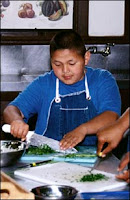I really like the idea behind "The Edible Schoolyard". Talk about hands on learning! The children at Martin Luther King Junior Middle School in Berkley, California grow their food and cook it in a classroom kitchen. What a great way to teach the science of plant life cycle while at the same time, teach the students a life skill like cooking. They are also learning about vegetables and how to eat healthy.
The idea for the garden was the brainchild of a chef/author Alice Waters, after having a conversation with the school principal who was unhappy with the current lunch program. Many of the school's menu items just weren't nutritionally sound. She wanted a way for the students to learn how to eat healthy foods while at the same time teach them where food comes from (other than the grocery store). The students are learning about fruits and vegetables that they may not have otherwise been willing to try. The teachers say that after the students grow the food and prepare it, they are more willing to eat it and try new things. Maybe I should plant a garden in my backyard to get my kids to eat more vegetables!
conversation with the school principal who was unhappy with the current lunch program. Many of the school's menu items just weren't nutritionally sound. She wanted a way for the students to learn how to eat healthy foods while at the same time teach them where food comes from (other than the grocery store). The students are learning about fruits and vegetables that they may not have otherwise been willing to try. The teachers say that after the students grow the food and prepare it, they are more willing to eat it and try new things. Maybe I should plant a garden in my backyard to get my kids to eat more vegetables!
The idea for the garden was the brainchild of a chef/author Alice Waters, after having a
 conversation with the school principal who was unhappy with the current lunch program. Many of the school's menu items just weren't nutritionally sound. She wanted a way for the students to learn how to eat healthy foods while at the same time teach them where food comes from (other than the grocery store). The students are learning about fruits and vegetables that they may not have otherwise been willing to try. The teachers say that after the students grow the food and prepare it, they are more willing to eat it and try new things. Maybe I should plant a garden in my backyard to get my kids to eat more vegetables!
conversation with the school principal who was unhappy with the current lunch program. Many of the school's menu items just weren't nutritionally sound. She wanted a way for the students to learn how to eat healthy foods while at the same time teach them where food comes from (other than the grocery store). The students are learning about fruits and vegetables that they may not have otherwise been willing to try. The teachers say that after the students grow the food and prepare it, they are more willing to eat it and try new things. Maybe I should plant a garden in my backyard to get my kids to eat more vegetables!A Night in the Global Village
This is another great program from Edutopia teaching students about world hunger. I like this video cast because they put the students in a situation that would be almost impossible to simulate in any classroom. The students are placed in a camp that is rigged to look like a village in an impoverished area. They are each assigned to a group and are given one of the supplies they will need to survive the night. One group will have the water supply, one the firewood, one some food, one the pots to cook in, etc. They have to work together with the other groups to make their meal for the night. They also have to sleep in huts and shacks with just a cot or a rug on the floor with no electricity or indoor plumbing.
This is a great way to teach students about how people in other parts of the world really live and what we take for granted. They learn that they just can't go to the refrigerator and take out a snack or a soft drink. They learn they have to work with others in the village just to survive.
This is a great way to teach students about how people in other parts of the world really live and what we take for granted. They learn that they just can't go to the refrigerator and take out a snack or a soft drink. They learn they have to work with others in the village just to survive.
My Take
Having a garden in the school yard would be an invaluable tool to teach students about the life cycle of plants and where most of our food comes from but it is not very feasible in most schools though. I would like my class to learn more about how plants grow and the different stages and also, be interested in trying new foods. Perhaps, we could plant some vegetables in the classroom in pots so they could get a little taste of what it's like to grow and nurture a living
thing.
The Global Village would be a great project for most students to experience but then again, it would also be hard to reenact in the classroom. I would like to teach my class about poverty and hunger. It is a hard concept for children to grasp when we live in a country where there is an abundance of food. They don't always understand that some children go to bed hungry every night. I would use the resources at Heifer International to show the students what other children are doing to help solve the hunger problem. Perhaps, we could get involved in a community project to help those in need such as Feed the Children or World Vision. I think community involvement is an essential part of the education process. I believe that Edutopia will be a great resource to me as a teacher to help students really get involved in their education and the world around them. Thanks, George Lucas for helping to provide ways to reach students beyond the traditional classroom setting.
Having a garden in the school yard would be an invaluable tool to teach students about the life cycle of plants and where most of our food comes from but it is not very feasible in most schools though. I would like my class to learn more about how plants grow and the different stages and also, be interested in trying new foods. Perhaps, we could plant some vegetables in the classroom in pots so they could get a little taste of what it's like to grow and nurture a living
thing.
The Global Village would be a great project for most students to experience but then again, it would also be hard to reenact in the classroom. I would like to teach my class about poverty and hunger. It is a hard concept for children to grasp when we live in a country where there is an abundance of food. They don't always understand that some children go to bed hungry every night. I would use the resources at Heifer International to show the students what other children are doing to help solve the hunger problem. Perhaps, we could get involved in a community project to help those in need such as Feed the Children or World Vision. I think community involvement is an essential part of the education process. I believe that Edutopia will be a great resource to me as a teacher to help students really get involved in their education and the world around them. Thanks, George Lucas for helping to provide ways to reach students beyond the traditional classroom setting.



No comments:
Post a Comment